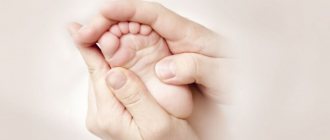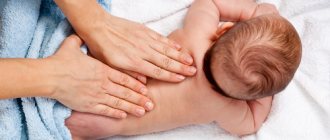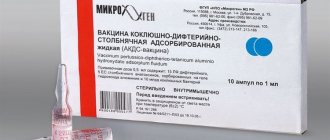Risk factors
The following reasons can cause increased tone of all muscles in a child, especially in the legs:
- unfavorable environmental situation,
- head injury during childbirth,
- toxicosis of the first and second half of gestation,
- bad habits of a pregnant woman (smoking, drinking alcohol),
- hypoxic state during labor,
- chronic diseases, as well as infections of women during pregnancy,
- prolonged or too rapid labor.
Increased tone of the legs and arms, which remains after a year, requires examination by a pediatric neurologist to exclude organic pathology of the nervous system.
Prevention of hypertonicity in the legs
You can prevent an increase in the tone of the legs using simple techniques:
- ensuring the baby’s physical activity (he should remain motionless in the crib only during sleep);
- elimination of excessive irritants of the nervous system (loud sounds, bright lights, noise effects);
- creating a calm atmosphere of psychological comfort in the family;
- A pregnant woman's adherence to the rules of a healthy lifestyle.
If parents have the slightest suspicion about hypertonicity in their child, it is necessary to make an appointment with a pediatric neurologist.
Symptoms of hypertension
Signs of muscle tension are:
- general restlessness and constant agitation of the baby,
- chin trembling while crying
- throwing your head back in your sleep,
- resistance when trying to spread the child’s arms and legs apart,
- support on the toes when lowering the baby onto a hard surface,
- frequent regurgitation.
If even a few of the listed symptoms appear, it is necessary to be examined by a specialist and prescribe a foot massage for hypertonicity, which will help relieve tension.
Consequences and danger
Increased tone in children cannot be ignored, as this phenomenon is fraught with the following complications:
- delayed development of motor function in a child,
- problems with the formation of gait and posture,
- delayed speech skills,
- coordination disorders.
Foot massage with increased muscle tone in a child can prevent serious disorders; this method is the leading one in the system of rehabilitation measures.
Where to start the exercises?
Almost all newborns, at the first opportunity, bend their legs to their tummy, keep their arms pressed to their chest, and clench their fists.
But normally, the tension should not be too strong, and when trying to unclench the fist or straighten the arms and legs, the mother should not feel any noticeable resistance. These are signs of physiological hypertonicity.
This is a normal condition for a baby, and by the age of six months the baby’s muscle tone should return to normal. In this case, a daily massage performed by mom, dad or another relative will be enough.
If, when opening a small fist, an adult feels noticeable resistance, this is a reason to seek advice from a specialist. Only a doctor can accurately identify pathological hypertonicity in a child. Pathological muscle hypertonicity can slow down the rate of physical development, as it interferes with the correct formation of motor skills. There is a high probability that over time the child may develop orthopedic problems such as gait and posture disorders. In some cases, increased muscle tone is a symptom of serious neurological pathologies, for example, metabolic diseases, disorders of brain development, cerebral palsy (CP) and others.
Pathological hypertonicity can be caused by:
- severe toxicosis in the mother in the first trimester of pregnancy (during this period all organs and systems of the child are formed);
- increased uterine tone during pregnancy;
- fetal hypoxia (lack of oxygen) during intrauterine development;
- colds and infectious diseases or anemia in the mother during pregnancy;
- various diseases of the nervous system in a child.
Before performing a baby massage at home, you should pay attention to ensuring the baby’s comfort and safety.
- The room should be well ventilated, the air temperature should be 20-25°C.
- It is necessary to prepare the surface on which the child will lie. The ideal option is a changing table. If it is not available, it is recommended to cover the table with a blanket and place a baby oilcloth and diaper on top of it.
- Various creams, oils, powders and other products are not recommended when performing this procedure, as they interfere with the access of oxygen to the delicate baby skin.
- The massage therapist's hands should be clean, without any jewelry. Before starting the massage, you should make sure that your hands are warm enough and their touch will not cause discomfort to the baby.
- The time for the procedure must also be chosen correctly. You should not massage before eating or immediately after eating. You need to wait at least 40 minutes. Also, you should not disturb your baby immediately after waking up. It is necessary to choose a time when the baby will be in a calm, relaxed state and in a good mood.
- All massage movements should be performed moving upward from the fingers in the direction of the blood vessels.
- When massage aimed at normalizing tone, preference should be given to stroking and kneading, and clapping and chopping movements should be avoided. The latter can provoke an increase in muscle tension.
- The duration of the procedure should be about five minutes for babies under three months and 7-10 minutes for children under one year.
Diagnostic methods (reflex tests)
To determine the indications for a relaxing massage, you will need to conduct tests that reveal signs of increased tone:
- it is difficult to tear the baby’s hands away from the chest when trying to sit him up from a lying position,
- an imitation of a step occurs if you hold the baby vertically,
- the baby stands on tiptoes,
- lying on your back, legs straightened, when turning onto your stomach, the lower limbs bend,
- when a lying child turns his head to the right, his right arm is extended forward, the leg on this side is extended, and the left one is bent,
- tilting the head towards the chest leads to flexion of the arms and extension of the legs.
The positive nature of reflex tests should cause caution if they are detected at four months or later.
Brief information about tone
Before performing a massage for hypertonicity of the legs and arms of a baby, you must first make sure that there are no pathological processes in the baby’s body. Almost all newborns in the first months of their life, at any opportunity, take their usual position (they stayed in this position for 9 months) - they begin to bend and press their legs to their tummy, clench their fists and curl slightly.
As noted above, there are several forms of hypertonicity - physiological and pathological. In the first case, attempts to straighten the legs or unclench the child’s fists should not cause strong resistance. Muscle tone returns to normal on its own by 6 months. But if you massage daily, it can return to normal by 3 months.
But with pathological hypertonicity, all attempts to unclench the child’s fists and legs are accompanied by strong resistance. And in this case, it is necessary to contact a specialist, because this sign may signal the development of serious diseases.
Increased muscle tone can cause a slowdown in physiological development, as it interferes with the formation of motor skills. At the same time, the likelihood of orthopedic problems becoming increasingly higher over time. The child has a disturbance in gait and posture. Sometimes hypertonicity in an infant can signal the development of neurological diseases, for example, disorders of brain development, cerebral palsy, etc.
Foot massage techniques
The massage therapist uses the following massage techniques:
- stroking,
- trituration,
- shaking.
All manipulations should be done carefully, gradually increasing the duration of the procedure.
Piston rubbing
The impact on the legs is carried out with two hands, between which the baby’s limb is located. Rubbing manipulations are carried out sequentially in different directions.
Squeezing movements
Massage of a child with hypertonicity of the legs must necessarily include the implementation of the techniques in question. To do this you need:
- give the baby a horizontal position on his back,
- clasp your knees with your hands and make pressing movements.
The pressure should be of medium intensity.
Shaking
To carry out this procedure, you need to grab the child by the shin area with both hands and swing it. Movements should be smooth and rhythmic.
What not to do?
Massage for infants does not involve intensive kneading, as well as patting and chopping techniques. These actions can increase muscle tension.
The use of various devices such as walkers and jumpers increases tension in the muscles of the pelvis and lower extremities. Therefore, their use is unacceptable for children with increased muscle tone.
How to do a relaxing massage for infants with hypertension
The number of sessions is usually about 10 procedures. As prescribed by a pediatric neurologist, the course can be repeated after a few months.
It is necessary to do a massage after an hour has passed after waking up and feeding the baby. The child should be calm and the air temperature in the room should be comfortable.
You can start massage from two weeks of age. If it is not possible to undergo a full course of treatment from a specialist, it is permissible to perform the procedures after training the parents. The first session must be performed by a qualified massage therapist. The second time the manipulation can be carried out by one of the parents, but under the supervision of medical personnel.
If after the session the tone increases, an urgent consultation with a neurologist is necessary to change the tactics of the procedure.
Conditions for massage
Massage should be carried out after a doctor’s prescription in the comfort of your home. The temperature in the room should be at least 25 degrees, the air humidity should be normal.
The room should be ventilated before the procedure. At least 40 minutes should pass from the moment of feeding
To make your child feel comfortable, you can purchase special oil for massage. Don't forget to trim your nails, it is very important to keep your hands warm and dry.
Massage for a one-year-old child is an integral procedure; it develops important skills in the baby.
Therapeutic massage for hypertension
A course of massage procedures can reduce excessive tension in the muscles of the legs; correctly performed manipulations will contribute to the correct development of motor function. A one-month-old baby needs to massage his legs for up to 5 minutes, and from the age of seven months, the duration of the procedure is usually 10 minutes.
Foot massage
Massaging a child's lower extremities is especially important as it affects walking function.
You will need to adhere to the following sequence:
- The baby's left leg above the ankle area should be placed between the index and middle fingers of the left hand.
- Carry out stroking with a smooth movement of the right hand in the direction from the foot to the thigh.
- Rub in the same direction with your fingertips using direct and spiral pressure from bottom to top, and then in the opposite direction.
- We massage the foot area with stroking and rubbing techniques in the direction from the toes to the heel.
- Using pressure from the massage therapist's index finger, a stroke-like effect is applied to the outer surface of the foot. The toes spread out to the sides like a fan.
- Kneading the foot is done by drawing a figure eight on the plantar surface and spiraling movements in the direction from the outer surface of the foot to the ankle joint.
In the same sequence, it is necessary to perform a series of massage procedures on the right leg.
After finishing the massage, you need to bend the child’s legs at the knee joints and lightly press on them towards the stomach.
Gently rub the inner surfaces of your feet against each other several times. At the end of the session, spread the limbs to the sides, the feet should be connected.
Buttocks and back massage
To relax the back muscles, the “swing” massage technique is used. To do this, the child is lifted, holding the armpit area. Holding it suspended, rock the baby's torso with smooth movements.
In a lying position, a series of rocking movements are also performed, with the hands fixing the occipital region and back.
Having placed the child on his stomach, it is necessary to rub the muscles of the back and buttocks with soft and smooth movements. The fingers of the massage therapist’s palm apply light point pressure to areas of muscle hypertonicity.
Stroking techniques on the back surface are carried out in the direction from the back of the head to the buttocks and lower back.
Gymnastics for hypertension in infants
With increased muscle tension, therapeutic exercises are just as necessary as massage and no less effective. Some exercises:
- Wiggle . This exercise can be done by holding the child under the arms and gently rocking him. It can be performed in both vertical and horizontal positions. It is recommended to do it in water when the child is washed in the bath.
- On the ball . Placing the baby with his stomach on the ball and holding him by the legs and back, gently rock him in different directions. Movements should be very smooth. When your child gets used to this exercise, try stretching his arms forward a little.
- Flexion and extension of the arms . These exercises need to be done in all possible positions - placing the baby on his stomach or on his side (we move the bent arms left and right, back and forth) or on his back (straightened arms are spread to the sides, crossed, raised up, rotational movements are made).
- Crawling . The child himself does not yet know how to crawl, but by placing him on his stomach and helping him move his arms and legs, you are thereby performing an effective gymnastic exercise.
- Spreading the legs to the side . You will most likely encounter resistance from the child, so this exercise should be done very carefully, without being too persistent.
Gymnastics will also benefit a completely healthy baby.
Cough massage for children as an effective method of sputum removal.
Read all about the technique and benefits of vibration massage for coughs for children here: https://vsetelo.com/dt-bolezni/kashel/vibracionnyj-massazh.html
Breathing massage for flexor hypertonicity
The child lies on his back. The massage therapist sequentially performs the following techniques:
- stroking the lateral surface of the pectoral muscles,
- the same action is carried out in the area of the intercostal spaces in the direction of the large intestine,
- in a position on the stomach, the trapezius muscle is stroked and rubbed.
Breathing relaxation massage is carried out in conjunction with gymnastic exercises.
https://youtu.be/N6mPSejSoM8











